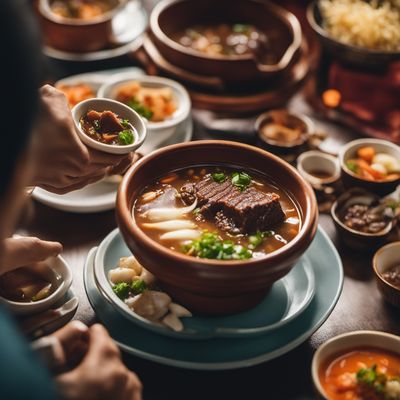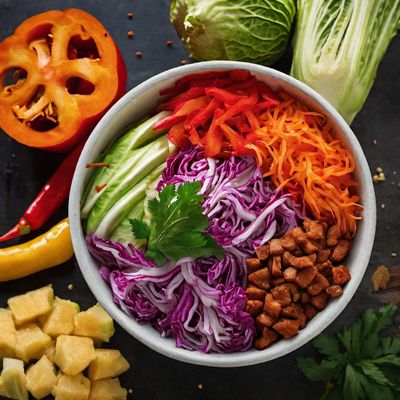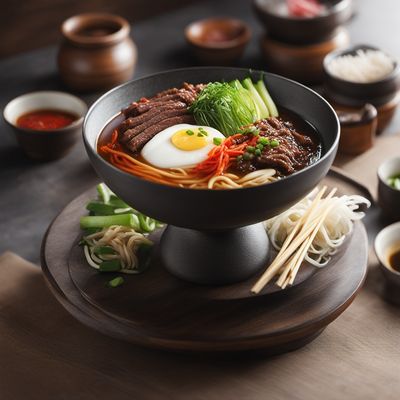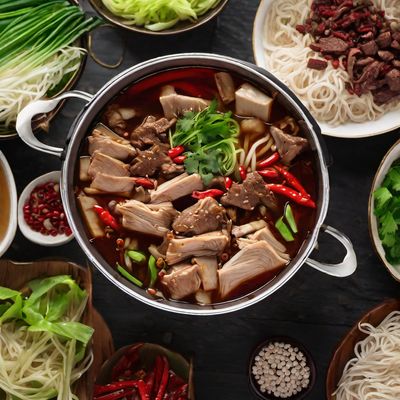
Recipe
Sichuan-style Spicy Kimchi
Fiery Fermented Delight: Sichuan-style Spicy Kimchi
4.8 out of 5
In the vibrant world of Sichuan cuisine, we bring you a fiery twist to the traditional Korean kimchi. Sichuan-style Spicy Kimchi combines the bold flavors of Sichuan peppercorns and chili with the tangy and fermented goodness of kimchi. Get ready to embark on a culinary adventure that will tingle your taste buds and leave you craving for more.
Metadata
Preparation time
30 minutes
Cooking time
0 minutes (fermentation time: 2-3 days)
Total time
2-3 days (including fermentation and refrigeration)
Yields
4 servings
Preparation difficulty
Easy
Suitable for
Vegetarian, Vegan, Gluten-free, Dairy-free, Low calorie
Allergens
Fish sauce (contains fish)
Not suitable for
Nut-free, Soy-free, Shellfish-free, Paleo, Keto
Ingredients
While the original Korean kimchi is known for its pungent and tangy flavors, Sichuan-style Spicy Kimchi adds a unique Sichuan twist. The use of Sichuan peppercorns and chili peppers infuses the kimchi with a numbing and spicy sensation, elevating the overall flavor profile. This adaptation brings together the best of both cuisines, creating a harmonious blend of heat and fermentation. We alse have the original recipe for Kimchi, so you can check it out.
-
1 large Napa cabbage, shredded (900g / 2 lbs) 1 large Napa cabbage, shredded (900g / 2 lbs)
-
1/4 cup (60ml) Sichuan chili flakes 1/4 cup (60ml) Sichuan chili flakes
-
2 tablespoons (30ml) Sichuan peppercorns, toasted and ground 2 tablespoons (30ml) Sichuan peppercorns, toasted and ground
-
3 tablespoons (45ml) fish sauce 3 tablespoons (45ml) fish sauce
-
2 tablespoons (30ml) soy sauce 2 tablespoons (30ml) soy sauce
-
2 tablespoons (30ml) rice vinegar 2 tablespoons (30ml) rice vinegar
-
2 tablespoons (30ml) sesame oil 2 tablespoons (30ml) sesame oil
-
1 tablespoon (15g) sugar 1 tablespoon (15g) sugar
-
4 cloves garlic, minced 4 cloves garlic, minced
-
1 thumb-sized ginger, grated 1 thumb-sized ginger, grated
-
4 green onions, chopped 4 green onions, chopped
-
1 medium carrot, julienned 1 medium carrot, julienned
-
1 daikon radish, julienned 1 daikon radish, julienned
-
1 tablespoon (15g) salt 1 tablespoon (15g) salt
Nutrition
- Calories (kcal / KJ): 80 kcal / 335 KJ
- Fat: 4g / 0.6g saturated
- Carbohydrates: 10g / 3g sugars
- Protein: 2g
- Fiber: 3g
- Salt: 2g
Preparation
-
1.In a large bowl, combine the shredded Napa cabbage and salt. Massage the cabbage for about 5 minutes to release its juices. Let it sit for 30 minutes, then rinse thoroughly and drain.
-
2.In a separate bowl, mix together the Sichuan chili flakes, Sichuan peppercorns, fish sauce, soy sauce, rice vinegar, sesame oil, sugar, garlic, ginger, and green onions.
-
3.Add the julienned carrot and daikon radish to the spice mixture and toss until well coated.
-
4.Gently squeeze any excess liquid from the cabbage and add it to the spice mixture. Mix everything together until the cabbage is evenly coated with the spice mixture.
-
5.Transfer the kimchi to a clean, airtight jar or container. Press it down firmly to remove any air bubbles and ensure the cabbage is fully submerged in the liquid.
-
6.Leave the jar at room temperature for 2-3 days to allow the kimchi to ferment. After that, refrigerate for at least 1 week before consuming to enhance the flavors.
Treat your ingredients with care...
- Napa cabbage — Make sure to thoroughly rinse the cabbage after salting to remove excess saltiness.
- Sichuan chili flakes — Adjust the amount according to your spice tolerance. Add more for extra heat or reduce for a milder flavor.
- Sichuan peppercorns — Toast the peppercorns in a dry pan over low heat until fragrant, then grind them using a mortar and pestle or a spice grinder.
- Fish sauce — Look for a vegetarian or vegan alternative if you prefer to avoid fish-based ingredients.
- Rice vinegar — Substitute with apple cider vinegar if rice vinegar is not available.
Tips & Tricks
- For a more intense flavor, allow the kimchi to ferment for a longer period.
- Use gloves when handling the Sichuan chili flakes and peppercorns to avoid skin irritation.
- Adjust the amount of chili flakes and peppercorns to suit your preferred level of spiciness and numbing sensation.
- Serve the kimchi as a side dish, in stir-fries, or as a topping for noodles or rice dishes.
- The longer the kimchi is refrigerated, the more complex and flavorful it becomes.
Serving advice
Serve Sichuan-style Spicy Kimchi as a side dish alongside your favorite Sichuan dishes, such as Mapo Tofu or Kung Pao Chicken. It also pairs well with steamed rice or noodles. The spicy and tangy flavors of the kimchi will complement the rich and bold flavors of Sichuan cuisine.
Presentation advice
Present the Sichuan-style Spicy Kimchi in a small ceramic dish or a traditional Korean kimchi jar. Garnish with a sprinkle of toasted sesame seeds and a few slices of green onion for an added touch of freshness. The vibrant red color of the kimchi will make it visually appealing and enticing.
More recipes...
For Kimchi » Browse all
For Korean cuisine » Browse all
More Korean cuisine dishes » Browse all

Saengseonjeon
Fried fish cake
Saengseonjeon is a Korean dish made with battered and fried fish.

Galbitang
Beef short rib soup
Galbitang is a Korean beef short rib soup that is hearty and comforting. It is a popular dish in Korea, especially during the winter months.

Hanjeongsal
Hanjeongsal (pork dish)
Hanjeongsal is a Korean dish made with grilled pork jowl.











